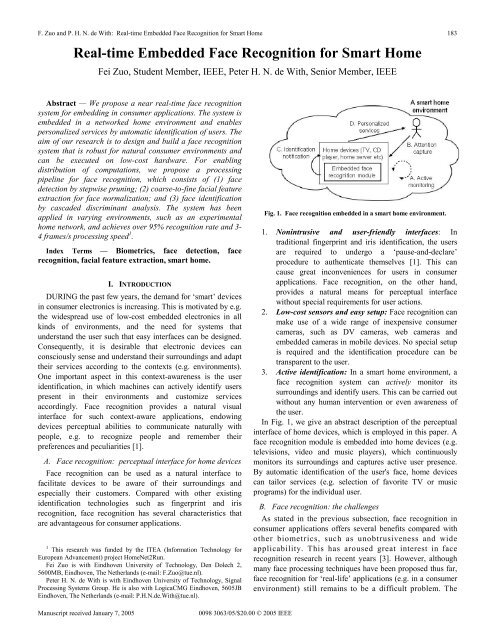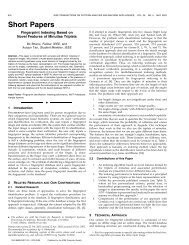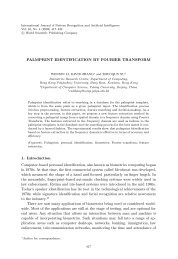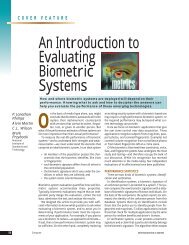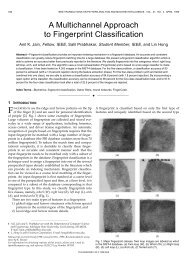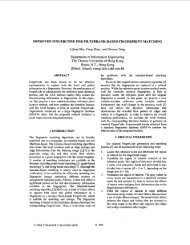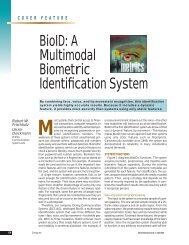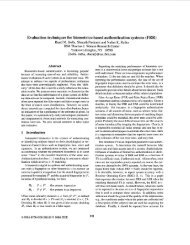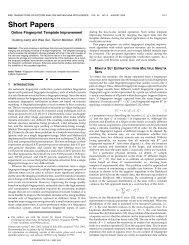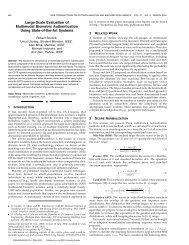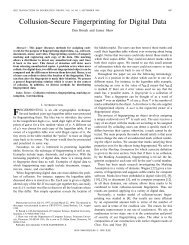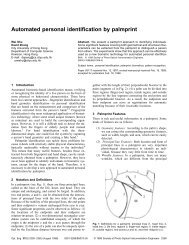Real-time embedded face recognition for smart home ... - IEEE Xplore
Real-time embedded face recognition for smart home ... - IEEE Xplore
Real-time embedded face recognition for smart home ... - IEEE Xplore
You also want an ePaper? Increase the reach of your titles
YUMPU automatically turns print PDFs into web optimized ePapers that Google loves.
F. Zuo and P. H. N. de With: <strong>Real</strong>-<strong>time</strong> Embedded Face Recognition <strong>for</strong> Smart Home<br />
183<br />
<strong>Real</strong>-<strong>time</strong> Embedded Face Recognition <strong>for</strong> Smart Home<br />
Fei Zuo, Student Member, <strong>IEEE</strong>, Peter H. N. de With, Senior Member, <strong>IEEE</strong><br />
Abstract — We propose a near real-<strong>time</strong> <strong>face</strong> <strong>recognition</strong><br />
system <strong>for</strong> embedding in consumer applications. The system is<br />
<strong>embedded</strong> in a networked <strong>home</strong> environment and enables<br />
personalized services by automatic identification of users. The<br />
aim of our research is to design and build a <strong>face</strong> <strong>recognition</strong><br />
system that is robust <strong>for</strong> natural consumer environments and<br />
can be executed on low-cost hardware. For enabling<br />
distribution of computations, we propose a processing<br />
pipeline <strong>for</strong> <strong>face</strong> <strong>recognition</strong>, which consists of (1) <strong>face</strong><br />
detection by stepwise pruning; (2) coarse-to-fine facial feature<br />
extraction <strong>for</strong> <strong>face</strong> normalization; and (3) <strong>face</strong> identification<br />
by cascaded discriminant analysis. The system has been<br />
applied in varying environments, such as an experimental<br />
<strong>home</strong> network, and achieves over 95% <strong>recognition</strong> rate and 3-<br />
4 frames/s processing speed 1 .<br />
Index Terms — Biometrics, <strong>face</strong> detection, <strong>face</strong><br />
<strong>recognition</strong>, facial feature extraction, <strong>smart</strong> <strong>home</strong>.<br />
I. INTRODUCTION<br />
DURING the past few years, the demand <strong>for</strong> ‘<strong>smart</strong>’ devices<br />
in consumer electronics is increasing. This is motivated by e.g.<br />
the widespread use of low-cost <strong>embedded</strong> electronics in all<br />
kinds of environments, and the need <strong>for</strong> systems that<br />
understand the user such that easy inter<strong>face</strong>s can be designed.<br />
Consequently, it is desirable that electronic devices can<br />
consciously sense and understand their surroundings and adapt<br />
their services according to the contexts (e.g. environments).<br />
One important aspect in this context-awareness is the user<br />
identification, in which machines can actively identify users<br />
present in their environments and customize services<br />
accordingly. Face <strong>recognition</strong> provides a natural visual<br />
inter<strong>face</strong> <strong>for</strong> such context-aware applications, endowing<br />
devices perceptual abilities to communicate naturally with<br />
people, e.g. to recognize people and remember their<br />
preferences and peculiarities [1].<br />
A. Face <strong>recognition</strong>: perceptual inter<strong>face</strong> <strong>for</strong> <strong>home</strong> devices<br />
Face <strong>recognition</strong> can be used as a natural inter<strong>face</strong> to<br />
facilitate devices to be aware of their surroundings and<br />
especially their customers. Compared with other existing<br />
identification technologies such as fingerprint and iris<br />
<strong>recognition</strong>, <strong>face</strong> <strong>recognition</strong> has several characteristics that<br />
are advantageous <strong>for</strong> consumer applications.<br />
1 This research was funded by the ITEA (In<strong>for</strong>mation Technology <strong>for</strong><br />
European Advancement) project HomeNet2Run.<br />
Fei Zuo is with Eindhoven University of Technology, Den Dolech 2,<br />
5600MB, Eindhoven, The Netherlands (e-mail: F.Zuo@tue.nl).<br />
Peter H. N. de With is with Eindhoven University of Technology, Signal<br />
Processing Systems Group. He is also with LogicaCMG Eindhoven, 5605JB<br />
Eindhoven, The Netherlands (e-mail: P.H.N.de.With@tue.nl).<br />
Fig. 1. Face <strong>recognition</strong> <strong>embedded</strong> in a <strong>smart</strong> <strong>home</strong> environment.<br />
1. Nonintrusive and user-friendly inter<strong>face</strong>s: In<br />
traditional fingerprint and iris identification, the users<br />
are required to undergo a ‘pause-and-declare’<br />
procedure to authenticate themselves [1]. This can<br />
cause great inconveniences <strong>for</strong> users in consumer<br />
applications. Face <strong>recognition</strong>, on the other hand,<br />
provides a natural means <strong>for</strong> perceptual inter<strong>face</strong><br />
without special requirements <strong>for</strong> user actions.<br />
2. Low-cost sensors and easy setup: Face <strong>recognition</strong> can<br />
make use of a wide range of inexpensive consumer<br />
cameras, such as DV cameras, web cameras and<br />
<strong>embedded</strong> cameras in mobile devices. No special setup<br />
is required and the identification procedure can be<br />
transparent to the user.<br />
3. Active identification: In a <strong>smart</strong> <strong>home</strong> environment, a<br />
<strong>face</strong> <strong>recognition</strong> system can actively monitor its<br />
surroundings and identify users. This can be carried out<br />
without any human intervention or even awareness of<br />
the user.<br />
In Fig. 1, we give an abstract description of the perceptual<br />
inter<strong>face</strong> of <strong>home</strong> devices, which is employed in this paper. A<br />
<strong>face</strong> <strong>recognition</strong> module is <strong>embedded</strong> into <strong>home</strong> devices (e.g.<br />
televisions, video and music players), which continuously<br />
monitors its surroundings and captures active user presence.<br />
By automatic identification of the user's <strong>face</strong>, <strong>home</strong> devices<br />
can tailor services (e.g. selection of favorite TV or music<br />
programs) <strong>for</strong> the individual user.<br />
B. Face <strong>recognition</strong>: the challenges<br />
As stated in the previous subsection, <strong>face</strong> <strong>recognition</strong> in<br />
consumer applications offers several benefits compared with<br />
other biometrics, such as unobtrusiveness and wide<br />
applicability. This has aroused great interest in <strong>face</strong><br />
<strong>recognition</strong> research in recent years [3]. However, although<br />
many <strong>face</strong> processing techniques have been proposed thus far,<br />
<strong>face</strong> <strong>recognition</strong> <strong>for</strong> ‘real-life’ applications (e.g. in a consumer<br />
environment) still remains to be a difficult problem. The<br />
Manuscript received January 7, 2005<br />
0098 3063/05/$20.00 © 2005 <strong>IEEE</strong>
184<br />
<strong>IEEE</strong> Transactions on Consumer Electronics, Vol. 51, No. 1, FEBRUARY 2005<br />
Fig. 2. Face <strong>recognition</strong> operation flow.<br />
relatively unconstrained operating environment imposes more<br />
challenges compared to conventional ‘smug-shot’ <strong>face</strong><br />
<strong>recognition</strong> such as used in security applications. These extra<br />
challenges include the following:<br />
1. Large variability of operating environments (e.g.<br />
illumination and backgrounds).<br />
2. Processing efficiency with low-cost consumer<br />
hardware.<br />
3. Nearly unconstrained capturing of facial images.<br />
In this paper, we present a consumer-oriented <strong>face</strong><br />
<strong>recognition</strong> system HomeFace, with special emphasis on the<br />
above challenges. The system is <strong>embedded</strong> in a <strong>smart</strong> <strong>home</strong><br />
environment <strong>for</strong> user identification as illustrated in Fig. 1.<br />
More specifically, the experimental environment consists of a<br />
<strong>home</strong> network using e.g. Ethernet and <strong>IEEE</strong>-1394 connections.<br />
A prototype of our <strong>recognition</strong> system was integrated in this<br />
network and successfully demonstrated at the IFA consumer<br />
electronics exhibition [2].<br />
The remainder of the paper is organized as follows. In<br />
Section II, we will give an overview of the HomeFace system<br />
architecture. The core of the system is a pipeline of three<br />
processing modules, namely, <strong>face</strong> detection, facial feature<br />
extraction <strong>for</strong> <strong>face</strong> normalization, and finally, <strong>face</strong><br />
identification. Sections III-V illustrate each processing module<br />
in more detail. In Section VI, we provide the experimental<br />
results and analyze the per<strong>for</strong>mance of the complete system.<br />
Section VII presents discussions and conclusions.<br />
II. ARCHITECTURE OVERVIEW OF HOMEFACE<br />
The <strong>embedded</strong> HomeFace system consists of a kernel<br />
component per<strong>for</strong>ming the <strong>face</strong> detection/<strong>recognition</strong> and an<br />
interfacing component providing a uni<strong>for</strong>m inter<strong>face</strong> to<br />
different hosting devices. The kernel component employs a<br />
Fig. 3. Algorithm architecture.<br />
processing pipeline consisting of <strong>face</strong> detection (attention<br />
capture), feature extraction <strong>for</strong> <strong>face</strong> normalization<br />
(preprocessing <strong>for</strong> classification), and <strong>face</strong> identification.<br />
A. Processing flow<br />
Fig. 2 portrays the operation flow of the HomeFace system.<br />
The system operates on live-feed video from <strong>embedded</strong><br />
cameras and per<strong>for</strong>ms the identification in near real <strong>time</strong>. For<br />
each frame, the system detects existing <strong>face</strong>s and keeps track<br />
of the located <strong>face</strong>s (Fig. 2, stage A). Motions of <strong>face</strong>s from<br />
the same user <strong>for</strong>m a smooth trajectory, and a new user can be<br />
easily identified by detecting a ‘break’ of this trajectory. Note<br />
that in both cases, the subsequent facial feature extraction and<br />
<strong>face</strong> identification are per<strong>for</strong>med. From all detected <strong>face</strong>s,<br />
those <strong>face</strong>s with large rotations (in-plane or out-of-plane<br />
rotation) or low resolutions are discarded. The remaining <strong>face</strong><br />
images are selected as key samples <strong>for</strong> further processing (Fig.<br />
2, stage B). To accommodate <strong>for</strong> varying <strong>face</strong> scale, position<br />
and pose, an accurate extraction of salient facial features is<br />
required <strong>for</strong> normalization purposes (Fig. 2, stage C).<br />
The final <strong>face</strong> identification (Fig. 2, stage D) searches <strong>for</strong> a<br />
database of reference <strong>face</strong>s and returns the ‘best-match’. For a<br />
user coming into the scene <strong>for</strong> the first <strong>time</strong> (Fig. 2, stage E), a<br />
minimum of k key samples need to be processed be<strong>for</strong>e an<br />
identification decision is made. For users already present in the<br />
scene, the identification result <strong>for</strong> the current frame will only<br />
contribute to the accumulated <strong>recognition</strong> confidence (Fig. 2,<br />
stage F). In this way, more stable identification can be<br />
achieved w.r.t. a sequence of <strong>face</strong> images.<br />
The processing pipeline can be executed on one single<br />
processing unit (the centralized mode) or distributed over a<br />
number of processing units connected by a <strong>home</strong> network (the<br />
distributed mode). In the distributed mode, different<br />
processing tasks (e.g. <strong>face</strong> detection, facial feature extraction
F. Zuo and P. H. N. de With: <strong>Real</strong>-<strong>time</strong> Embedded Face Recognition <strong>for</strong> Smart Home 185<br />
Fig. 4. The color-based <strong>face</strong> detector at the first stage.<br />
and <strong>face</strong> identification) can be carried out at various locations<br />
in a <strong>home</strong> network. The task distribution enables the execution<br />
of the software on multiple low-end hardware plat<strong>for</strong>ms,<br />
thereby reducing the total cost. Furthermore, since the chain of<br />
processing tasks <strong>for</strong>m a pipeline, the distribution of tasks can<br />
enable parallel processing and/or high processing efficiency.<br />
B. Image processing algorithm architecture<br />
Fig. 3 shows that three key steps are involved in the <strong>face</strong><br />
processing pipeline, namely, <strong>face</strong> detection, facial feature<br />
extraction <strong>for</strong> <strong>face</strong> normalization and <strong>face</strong> identification. These<br />
key steps interpret human <strong>face</strong>s with incremental semantic<br />
levels. The three key processing steps sequentially answer the<br />
following questions: if a human <strong>face</strong> is present in the scene,<br />
where the key facial features are (e.g. eyes and mouth), and<br />
what identity the <strong>face</strong> represents. Note that the answer to each<br />
question is built up upon the understanding of the previous<br />
questions (see the vertical incremental <strong>face</strong> interpretation<br />
arrow in Fig. 3).<br />
Orthogonally, within each processing step, a set of<br />
component algorithms are cascaded into a chain, where the<br />
outputs from the previous algorithms act as the inputs <strong>for</strong> the<br />
subsequent algorithms. The subsequent algorithms operate at<br />
finer granularity and further improve the results generated by<br />
the previous algorithms. By step-wise refinements (Fig. 3),<br />
high system per<strong>for</strong>mance can be achieved in terms of both<br />
robustness and processing efficiency.<br />
In the following Sections (III to V), we present each stage in<br />
more detail.<br />
III. FACE DETECTION<br />
Tremendous ef<strong>for</strong>t has been spent on designing <strong>face</strong><br />
detection techniques in the past decade [4]. A variety of image<br />
features are adopted, such as color, edges, image pixels in the<br />
spatial domain and trans<strong>for</strong>med image signals in DCT/Wavelet<br />
domain. Based on these features, various classifiers are built to<br />
discriminate <strong>face</strong> regions from non-<strong>face</strong> background regions.<br />
However, it is difficult <strong>for</strong> one single technique to achieve<br />
both robustness and training/processing efficiency<br />
simultaneously. For example, <strong>face</strong> detectors based on skincolor<br />
segmentation (e.g. [5]) are relatively fast, but colorfeatures<br />
alone are insufficient <strong>for</strong> the accurate discrimination<br />
between <strong>face</strong>s and non-<strong>face</strong>s. Conversely, learning-based<br />
techniques (e.g. Support Vector Machine [6]) offer more<br />
robust detection per<strong>for</strong>mance, however, they usually involve<br />
high training/processing complexity, which can be too costly<br />
<strong>for</strong> consumer use.<br />
To build a <strong>face</strong> detector that is highly efficient and robust,<br />
we use a detector cascade [7] that employs successive <strong>face</strong><br />
detectors with incremental complexity and detection<br />
capability. The detectors are cascaded in such a way that each<br />
detector progressively restricts the possible <strong>face</strong> candidates<br />
into fewer areas (see Fig. 3), thereby improving the overall<br />
per<strong>for</strong>mance in a step-wise manner. The detector cascade<br />
consists of a skin-color-based <strong>face</strong> detector, a geometry-based<br />
<strong>face</strong> detector and a Neural-Network-based (NN) <strong>face</strong> detector.<br />
The detector cascade offers the following advantages:<br />
1. Various image features are used including color,<br />
geometry and direct image pixels in the spatial domain.<br />
These features complement each other and capture<br />
different properties of the <strong>face</strong> images.<br />
2. The initial detectors are capable of quickly pruning<br />
large areas of non-<strong>face</strong> background regions, which<br />
significantly reduces the number of candidate regions<br />
<strong>for</strong> the final learning-based detector. This largely<br />
reduces the overall computation cost, while still<br />
retaining high detection accuracy.<br />
A. Color-based <strong>face</strong> detector<br />
Color in<strong>for</strong>mation has been proven to be an effective image<br />
feature <strong>for</strong> coarsely locating potential facial regions. We<br />
analyzed a sample set of facial pixels taken from pictures of<br />
people of different race, gender, age and under various lighting<br />
conditions. We have found that the chrominance components<br />
( Cb, Cr)<br />
in the YCbC r<br />
color space <strong>for</strong>m a condensed cluster.<br />
We have fit a convex hull to the skin-color cluster in the<br />
Cb<br />
− Cr<br />
plane. Skin-regions in an input image can be quickly<br />
determined by checking a look-up table (see Fig. 4). In<br />
addition to pixel-based color verification, we apply a binary<br />
majority filter as a post-processor to smooth the segmentation<br />
result.<br />
Notice that the color pruning criterion used in this stage is<br />
quite relaxed, resulting in a higher false acceptance rate than a<br />
more intricate color-based detection approach. However, <strong>for</strong><br />
an initial detector in the whole detector cascade, we intend to<br />
put more emphasis on speed than accuracy and the overall<br />
detection per<strong>for</strong>mance is rein<strong>for</strong>ced by the succeeding
186<br />
<strong>IEEE</strong> Transactions on Consumer Electronics, Vol. 51, No. 1, FEBRUARY 2005<br />
FERET <strong>face</strong> database [9], and 10 self-recorded video<br />
sequences simulating consumer <strong>home</strong> environments. We<br />
obtained an average of 92% percent detection rate. For the test<br />
on video sequences, the detector achieves approximately 0.1<br />
second/frame processing speed, with a frame resolution of<br />
320× 240 pixels, using a Pentium IV PC (1.7 GHz).<br />
detectors.<br />
Fig. 5. The geometry-based <strong>face</strong> detector, left: sliding windows <strong>for</strong> eyes<br />
and mouth; right: vertical intensity profiles of the <strong>face</strong> window.<br />
B. Geometry-based <strong>face</strong> detector<br />
In order to select potential <strong>face</strong> areas present in the skin<br />
blobs acquired in the first detector, we enumerate all small<br />
windows ( 20 × 20 pixels) extracted from each skin blob at<br />
every position and scale. This is similar to the image pyramid<br />
architecture used by Rowley et al. [8]. For each window, we<br />
apply a geometry-based <strong>face</strong> structure detector which<br />
examines the triangle-relationship between eye and mouth<br />
regions. The algorithm of the geometry-based <strong>face</strong> detector is<br />
summarized as follows.<br />
Algorithm 1: The geometry-based <strong>face</strong> verification.<br />
1. Generate the vertical profile of the candidate region<br />
(Fig. 5 right side);<br />
2. Select local minima of the profile as candidate vertical<br />
locations of eyes and mouth. If no proper minima are<br />
found, return non-<strong>face</strong>;<br />
3. For each candidate vertical location, a sliding window<br />
is applied to search horizontally <strong>for</strong> the most probable<br />
eye-pair (or mouth). The average region intensity is<br />
used as a fast evaluation criterion. If the lowest<br />
average intensity is above a threshold, return non-<strong>face</strong>;<br />
4. Check whether the selected feature group (eyes +<br />
mouth) <strong>for</strong>ms an approximate equilateral triangle. If<br />
not, return non-<strong>face</strong>.<br />
C. Learning-based detector<br />
For the final detector in the cascade, a neural-network-based<br />
(NN) detector is used. Its purpose is the final verification of<br />
facial regions and its principle is quite similar to Rowley's<br />
approach [8]. Since the previous detectors in the cascade<br />
already discard a large portion of background regions, only a<br />
small number of ambiguous candidates are passed to the NN<br />
detector. This significantly reduces the potential high<br />
computation cost of the NN detector. In the following, we<br />
provide quantitative results of our proposed <strong>face</strong> detector<br />
cascade.<br />
D. Evaluation<br />
To evaluate the per<strong>for</strong>mance of our proposed detector<br />
cascade, we use a test data set composed of color images<br />
downloaded from the Internet (most of them from Yahoo News<br />
photo gallery), randomly selected samples from the color<br />
IV. FACIAL FEATURE EXTRACTION AND FACE<br />
NORMALIZATION<br />
The outputs from the <strong>face</strong> detector (see the previous<br />
subsection) contain <strong>face</strong>s with varying scale, position and<br />
pose. The direct use of unaligned facial images will potentially<br />
lead to identification failures. To this end, we need an accurate<br />
extraction of salient facial features <strong>for</strong> normalization purposes.<br />
One earlier approach <strong>for</strong> feature extraction is proposed by<br />
Yuille et al. [10]. In this approach, parameterized de<strong>for</strong>mable<br />
templates are used to minimize a predefined fitting function.<br />
However, it is too computationally expensive <strong>for</strong> consumer<br />
use. More recently, the Active Shape Model (ASM) and<br />
Active Appearance Model (AAM) [11] were proposed as two<br />
effective techniques <strong>for</strong> feature extraction. In those techniques,<br />
a constrained statistical shape model is adopted, which offers<br />
fast and stable per<strong>for</strong>mance. However, both ASM and AAM<br />
suffer from wrong convergence when the model is not<br />
initialized sufficiently close to the real <strong>face</strong> position.<br />
We propose a two-step coarse-to-fine feature extractor [12]<br />
as shown in Fig. 3. First, we use Edge Orientation Matching<br />
(EOM) [13] <strong>for</strong> a fast determination of approximate facial<br />
feature positions within the detected <strong>face</strong> region. This ensures<br />
a ‘close’ initialization of the shape model used by the second<br />
step, alleviating the wrong convergence problem caused by<br />
improper model initializations. Second, H-ASM (an enhanced<br />
version of ASM) is adopted to iteratively fit a statistical shape<br />
model to the input image. Note that in contrast with ASM, we<br />
use 2-D Haar-wavelet-based texture attributes in H-ASM to<br />
guide the de<strong>for</strong>mation process, which facilitates increased<br />
robustness and fast processing.<br />
A. Feature estimation by EOM<br />
Since prominent facial features like eyes and mouth are<br />
often characterized by relatively pronounced edges, edge<br />
in<strong>for</strong>mation (with both strength and orientation) proved to be<br />
effective in <strong>face</strong> processing [13]. The edge map of a given<br />
image region is obtained by convolving the image with a<br />
horizontal and vertical 3× 3 Sobel edge filter. Based on the<br />
convolution results ( SX<br />
( x, y)<br />
and SY<br />
( x, y )), the Edge-Strength<br />
image ( ES ) and the Edge-Orientation image ( EO ) are<br />
generated, given by<br />
2 2<br />
ES( x, y) = SX( x, y) + SY( x, y),<br />
SY<br />
( x, y)<br />
(1)<br />
EO( x, y) = arctan .<br />
SX<br />
( x, y)<br />
Using the average ES and EO as a template, a multiresolution<br />
search is per<strong>for</strong>med over the detected facial region<br />
<strong>for</strong> the position and scale yielding the best match (Fig. 6). The
F. Zuo and P. H. N. de With: <strong>Real</strong>-<strong>time</strong> Embedded Face Recognition <strong>for</strong> Smart Home 187<br />
matching function between two image regions P 1<br />
and P 2<br />
is<br />
defined as [13]:<br />
M ( P, P ) = ∑∑ d ( x, y),<br />
and (2)<br />
1 2<br />
x<br />
⎧sin( EO1( x, y) − EO2( x, y)),<br />
⎪<br />
de( x, y) = ⎨ if ES1( x, y), ES2( x, y) > T;<br />
(3)<br />
⎪<br />
⎩1, otherwise,<br />
where ES<br />
i<br />
( EO<br />
i<br />
) represents the ES (EO ) image of P i<br />
( i = 1, 2 ), respectively. The parameter T is a threshold.<br />
y<br />
e<br />
3) Haar feature selection<br />
From the above, each local feature attribute vector T r i<br />
can be<br />
represented by a trans<strong>for</strong>med data vector<br />
r<br />
T<br />
Ti = ( H2( Fi), H3( Fi),..., Hc( Fi)) , (4)<br />
where Hk( F<br />
i)<br />
gives the k-th (in zigzag order) Haar<br />
coefficient 2 of the M × M block surrounding F<br />
i<br />
. Only a part,<br />
say c where c M × M , of the total coefficients are selected,<br />
due to the highly compact description of the local feature<br />
structure after Haar trans<strong>for</strong>mation. For most feature points,<br />
less than 4% of the total coefficients are required to retain up<br />
to 95% of the signal energy. Note that c can be variable to<br />
adapt to different feature structures. This significantly<br />
increases the efficiency of the algorithm and reduces the<br />
interference of the image noise.<br />
Fig. 6. Feature estimation by EOM.<br />
B. De<strong>for</strong>mable shape fitting by H-ASM<br />
1) Facial feature model with enhanced Haar textures<br />
In this stage, we build a facial feature model as an ordered<br />
set of N<br />
f<br />
feature points, as shown in Fig. 7. For each feature<br />
r r<br />
point F (1 ≤i<br />
≤ N ), we define an attribute pair 〈 P,<br />
T 〉 ,<br />
i<br />
f<br />
where P r i<br />
specifies the coordinates of F<br />
i<br />
and T r i<br />
describes the<br />
local 2-D texture structure of F i<br />
. We employ 2-D local<br />
textures because they contain richer and more reliable pattern<br />
in<strong>for</strong>mation than 1-D profiles normal to the contour. The latter<br />
is widely used in gradient-based de<strong>for</strong>mable models, such as<br />
ASM. In our case, we model T r i<br />
by extracting an M × M<br />
block around F i<br />
from the image, which is subsequently<br />
trans<strong>for</strong>med using the Haar-trans<strong>for</strong>m <strong>for</strong> robustness and<br />
processing efficiency. A closer examination of the local<br />
feature patterns in <strong>face</strong> images shows that they usually contain<br />
relatively simple patterns with strong contrast. The 2-D basis<br />
images of the Haar-trans<strong>for</strong>m match quite well with these<br />
patterns, so that it is attractive to exploit them <strong>for</strong> efficient<br />
signal representation. Furthermore, the simplicity of the Haartrans<strong>for</strong>m<br />
supports the requirement of a real-<strong>time</strong><br />
implementation.<br />
2) Fast computation of Haar textures<br />
Haar decomposition mainly involves summations of pixel<br />
sub-blocks (see the example Haar basis images shown in Fig.<br />
7), which can be efficiently computed by using two auxiliary<br />
‘integral images’ [14]. Furthermore, the illumination<br />
normalization <strong>for</strong> each block (by zero mean and one standard<br />
deviation) can be conveniently integrated into the computation<br />
of Haar coefficients. Interested readers are referred to [12] <strong>for</strong><br />
a more detailed explanation of the procedure <strong>for</strong> the fast<br />
computation of Haar coefficients.<br />
i<br />
i<br />
Fig. 7. Topological shape with local textures modelled by Haar<br />
wavelets.<br />
4) Haar feature weighting<br />
The selected coefficients Hk( F<br />
i)<br />
(1 ≤k ≤ c) may not be of<br />
equal importance to characterize F i<br />
. Coefficients with large<br />
variances <strong>for</strong> different <strong>face</strong> images may contain ‘noisy’ features<br />
and should be suppressed. There<strong>for</strong>e, a feature weighting<br />
scheme is adopted, which assigns more weights (higher<br />
importance) to those coefficients with less variance over a set of<br />
training samples. To this end, Equation (4) is rewritten to:<br />
r<br />
T<br />
Ti = ( H2( Fi) / σ2, H3( Fi) / σ3,..., Hc( Fi) / σc) , (5)<br />
where σ<br />
k<br />
(1 ≤k ≤ c) represents the standard deviation of<br />
Hk( F<br />
i)<br />
. In this sense, more stable coefficients are emphasized,<br />
which exert more influence in the subsequent feature matching<br />
(see the section below).<br />
5) Feature extraction by H-ASM<br />
From the initial estimation of the feature position, an initial<br />
shape model can be overlayed to the real image (see Fig. 6(e)).<br />
To extract N<br />
f<br />
key feature points, the shape model is de<strong>for</strong>med<br />
to fit to the real image in an alternating two-step procedure.<br />
2 Note that H<br />
1<br />
( F i ) = 0 , due to the illumination normalization.
188<br />
1. For each feature point F i<br />
, a local optimal position is<br />
searched along a trace composed of eight radial lines<br />
originating from the current model point. The search is<br />
based on evaluating the Euclidean distance between the<br />
current local feature attribute T r i<br />
(Equation (5)) and an<br />
average T r<br />
i<br />
computed over a set of manually labeled<br />
training <strong>face</strong> images.<br />
2. The shape is updated and regulated to maintain a<br />
plausible <strong>face</strong> shape based on the PCA-based (Principal<br />
Component Analysis) shape statistics, which is similar<br />
to ASM.<br />
C. Face normalization<br />
Assuming all feature points are coplanar and the <strong>face</strong><br />
remains essentially rigid, we use an affine trans<strong>for</strong>mation to<br />
warp an input <strong>face</strong> with varying scale, position and pose (with<br />
slightly non-frontal view) to a standard frame. Suppose the<br />
extracted feature locations are { P r r<br />
i<br />
}, where P ( , ) T<br />
i<br />
= xi yi<br />
(1 ≤i<br />
≤ N<br />
f<br />
), and the feature locations of a standard <strong>face</strong> are<br />
{ P r i<br />
}. By establishing correspondences between P r i<br />
and P r i<br />
, we<br />
can quickly estimate the six affine parameters a<br />
j<br />
(1≤ j ≤ 6)<br />
by minimizing the following:<br />
2<br />
∑ F( Pa r i, 1, a2,..., a6)<br />
− P<br />
r i<br />
, (6)<br />
i<br />
r<br />
r<br />
where F( Pi, a1, a2,..., a6) = Pi'<br />
represents an affine<br />
trans<strong>for</strong>mation that maps P r i<br />
to P r i<br />
' with parameters a j<br />
(1≤ j ≤ 6). This can be solved as a standard least-squaresfitting<br />
problem. Based on the estimated parameters, the affine<br />
warping is per<strong>for</strong>med on the original detected <strong>face</strong> to obtain a<br />
geometrically normalized <strong>face</strong>.<br />
Furthermore, a photometric normalization (by zero mean<br />
and one standard deviation) is per<strong>for</strong>med on the geometrically<br />
normalized <strong>face</strong> <strong>for</strong> illumination correction.<br />
D. Evaluation<br />
We have tested our facial feature extraction algorithm on a<br />
subset of FERET and AR <strong>face</strong> databases [9] [15]. Our<br />
proposed H-ASM has achieved doubled convergence area<br />
compared with the conventional ASM, while retaining a<br />
similar low computation cost (30-70 ms on a Pentium-IV PC,<br />
1.7GHz). The initial feature estimation step in Section IV-A is<br />
able to bring the initial shape into the convergence area of H-<br />
ASM, thereby further increasing the stability of the feature<br />
extraction. For converged cases, our feature extraction<br />
approach achieves an average point-to-point error of 4-7<br />
pixels.<br />
V. FACE IDENTIFICATION<br />
The normalized <strong>face</strong> image (Section IV-C) is then supplied<br />
to an image-based classifier, where it is compared with a<br />
database of N <strong>face</strong>s. Due to large variations in illumination,<br />
<strong>IEEE</strong> Transactions on Consumer Electronics, Vol. 51, No. 1, FEBRUARY 2005<br />
expression and pose, <strong>face</strong> images from one person <strong>for</strong>m a<br />
highly complex distribution in the image space, causing great<br />
difficulties in discriminating different persons. Existing<br />
subspace-based <strong>face</strong> <strong>recognition</strong> approaches (e.g. PCA<br />
(Principal Component Analysis) [16] and LDA (Linear<br />
Discriminant Analysis) [17] concentrate on deriving a<br />
trans<strong>for</strong>med <strong>face</strong> representation space Φ , in which <strong>face</strong><br />
clusters from different persons are better separated. Based on a<br />
metric d Φ , the nearest-neighbor (NN) rule is widely applied to<br />
find the closest match to a probe <strong>face</strong> image p from a <strong>face</strong><br />
database. However, we have found that using one single<br />
(distance) metric is insufficient <strong>for</strong> completely discriminating<br />
all persons. There<strong>for</strong>e, we propose a <strong>face</strong> classifier based on a<br />
multistage rejection-based LDA (Fig. 3), where unlikely<br />
candidates are gradually rejected until the best-match is found.<br />
Fig. 8. Face identification by cascaded rejection.<br />
The multistage rejection-based <strong>face</strong> identification algorithm<br />
is summarized as follows.<br />
Algorithm 2: Face identification by cascaded rejection.<br />
Input: A <strong>face</strong> database G<br />
0<br />
of N<br />
0<br />
persons, each having T i<br />
( 1≤i ≤ N0<br />
) sample images. A probe <strong>face</strong> image p.<br />
Training: Per<strong>for</strong>m a linear discriminant analysis on N 0<br />
persons and derive a classifier A 0<br />
.<br />
Identification:<br />
1. Let A = A0<br />
, G = G0<br />
and N = N0<br />
.<br />
2. Compare p with N candidates under A and select K<br />
candidates with highest rankings. Reject the rest N – K<br />
candidates.<br />
3. Train a new classifier A' using a local one-versus-all<br />
linear discriminant analysis on set G' ( G'<br />
⊂ G )<br />
containing only the selected K persons.<br />
4. If the best-match is found, stop; else let A = A', N = N -<br />
K, and G = G’, and goto 2) in the identification stage.<br />
In the above identification framework, refined<br />
classifications are per<strong>for</strong>med over gradually reduced candidate<br />
sets. For each stage, a different metric is defined <strong>for</strong> increased<br />
discrimination of the remaining candidates, thereby increasing<br />
the overall identification per<strong>for</strong>mance (see also Fig. 8).<br />
VI. EXPERIMENTAL RESULTS<br />
A. Experiments with the HomeFace system<br />
To evaluate the per<strong>for</strong>mance of HomeFace system, we have
F. Zuo and P. H. N. de With: <strong>Real</strong>-<strong>time</strong> Embedded Face Recognition <strong>for</strong> Smart Home 189<br />
Fig. 9. Processing stages <strong>for</strong> <strong>face</strong> <strong>recognition</strong>. (1) Face detection. (2) Feature estimation. (3) Extracted features. (4) Normalized <strong>face</strong> <strong>for</strong><br />
<strong>recognition</strong>.<br />
per<strong>for</strong>med real-life tests in a variety of indoor environments,<br />
capturing a wide range of <strong>home</strong> situations.<br />
Fig. 9 shows some intermediate <strong>face</strong> processing results prior<br />
to the final identification. The processing gives good<br />
per<strong>for</strong>mance with respect to different environments and<br />
complex backgrounds. For the identification, we set up a <strong>face</strong><br />
database composed of 25 people. Each person has 4 to 8<br />
sample pictures. For tests under a variety of environments, the<br />
integrated HomeFace system achieves a total <strong>recognition</strong> rate<br />
of 95% percent. Furthermore, the operation is computationally<br />
efficient, with a 3-4 frames/second processing speed on a P-IV<br />
PC in the centralized mode. Fig. 10 shows some examples of<br />
the <strong>face</strong> identification results in two typical testing<br />
environments.<br />
To accommodate <strong>for</strong> large variances in illumination and<br />
<strong>face</strong> appearances over <strong>time</strong>, the HomeFace system has a ‘selfdeveloping’<br />
nature, where samples that are not correctly<br />
identified are progressively added to the training set. In this<br />
way, the per<strong>for</strong>mance of the system can be gradually improved<br />
by learning from past experiences.<br />
Fig. 10. Sample results from HomeFace.<br />
B. Application embedding<br />
The HomeFace system was <strong>embedded</strong> in a number of <strong>home</strong><br />
applications to facilitate ‘<strong>smart</strong>’ user interactions. Specifically,<br />
we have integrated HomeFace into a user management and<br />
authentication software running on a <strong>home</strong> server, which<br />
actively identifies <strong>home</strong> users and ‘pushes’ user<br />
Fig. 11. Web inter<strong>face</strong> <strong>for</strong> <strong>smart</strong> TV program selection by <strong>face</strong><br />
<strong>recognition</strong>.<br />
identity in<strong>for</strong>mation to a number of <strong>home</strong> devices such as<br />
televisions and music players. Accordingly, TV and music<br />
programs can be automatically selected on a personalized<br />
basis. In Fig. 11, we give an example web inter<strong>face</strong> <strong>for</strong> <strong>smart</strong><br />
TV program selection. A successful demonstration was<br />
presented at the IFA consumer electronics exhibition [2].<br />
We have also implemented the HomeFace system in the<br />
distributed mode, where the <strong>face</strong> detection and feature<br />
extraction/<strong>face</strong> identification are carried out at different<br />
processing units in a <strong>home</strong>. The task distribution enables the<br />
execution of the software on multiple low-end hardware<br />
plat<strong>for</strong>ms, thereby reducing the hardware cost. The only extra<br />
cost is the in<strong>for</strong>mation exchange between different processing<br />
units. By using MPEG-4 object-based coding of extracted<br />
<strong>face</strong>s, we achieved a very low bit-rate network transmission of<br />
less than 5KBps.
190<br />
VII. CONCLUSION<br />
In this paper, we have presented a fast <strong>embedded</strong> <strong>face</strong><br />
<strong>recognition</strong> system <strong>for</strong> <strong>smart</strong> <strong>home</strong> applications. In contrast<br />
with highly constrained <strong>face</strong> <strong>recognition</strong> under consistent<br />
environments, our proposal concentrates on robust real-life<br />
<strong>recognition</strong> under unconstrained environments. Furthermore,<br />
processing efficiency and low-cost are our major concerns. To<br />
meet these requirements, we developed a pipeline of <strong>face</strong><br />
processing algorithms, namely, <strong>face</strong> detection, facial feature<br />
extraction <strong>for</strong> <strong>face</strong> normalization, and <strong>face</strong> identification.<br />
During each processing stage, we use step-wise refinements<br />
<strong>for</strong> improved robustness and efficiency. The system has<br />
achieved over 95% <strong>recognition</strong> rate and 3-4 frames/sec.<br />
processing speed.<br />
Our proposed <strong>face</strong> <strong>recognition</strong> system has a relatively<br />
unconstrained operation environment and offers high<br />
processing efficiency using low-cost hardware. This is<br />
especially attractive <strong>for</strong> consumer <strong>home</strong> applications, where<br />
easy user inter<strong>face</strong>s and low expenses are of most interest. In a<br />
distributed version of the <strong>face</strong> <strong>recognition</strong> system, the <strong>face</strong><br />
processing pipeline is distributed over a number of different<br />
processing units. The distribution may be such that expensive<br />
computations are per<strong>for</strong>med by units that have ample<br />
computation power, so that the overall processing cost is<br />
reduced considerably. For example, in a surveillance<br />
application, <strong>face</strong> detection is done at the <strong>home</strong> entrance, and<br />
the feature extraction and <strong>face</strong> identification is carried out on a<br />
media server in the <strong>home</strong>.<br />
The current HomeFace system is able to handle (near) frontview<br />
<strong>face</strong>s with out-of-plane rotation within ± 20 degrees.<br />
Larger head-pose variations are not considered in the<br />
<strong>recognition</strong>. Future research is still required to handle large<br />
head rotations to facilitate more natural user inter<strong>face</strong>s.<br />
ACKNOWLEDGMENT<br />
The authors would like to thank Frank van Tuijl and Peter<br />
van Grinsven from Philips Research Labs. Eindhoven <strong>for</strong> their<br />
support <strong>for</strong> the integration of the HomeFace <strong>face</strong> <strong>recognition</strong><br />
system into the HomeNet2Run demonstrator.<br />
REFERENCES<br />
[1] A. Pentland and T. Choudhury, “Face <strong>recognition</strong> <strong>for</strong> <strong>smart</strong><br />
environments”', <strong>IEEE</strong> Computer, vol. 33, no. 2, pp. 50-55, Feb. 2000.<br />
[2] HomeNet2Run project website, http://www.extra.research.philips.com/<br />
euprojects/hn2r/.<br />
[3] W. Zhao, R. Chellappa, P.J. Philips and A. Rosenfeld, “Face<br />
<strong>recognition</strong>: A literature survey”, ACM Computing Surveys, Vol. 35, no.<br />
4, pp. 399-458, Dec. 2003.<br />
[4] M.-H. Yang, D. Kriegman, and N. Ahuja, “Detecting <strong>face</strong>s in images: A<br />
Survey”, <strong>IEEE</strong> Trans. on Pattern Analysis and Machine Intelligence,<br />
vol. 24, no. 1, pp. 34-58, 2002.<br />
[5] J. Yang, W. Lu and A. Waibel, “Skin-color modelling and adaptation”,<br />
Proc. ACCV, pp. 687-694, 1998.<br />
[6] Y. Ma and X. Ding, “Face detection based on hierarchical Support<br />
Vector Machines”, Proc. ICPR, pp. 222-225, 2002.<br />
[7] F. Zuo and P.H.N. de With, “Fast human <strong>face</strong> detection using<br />
successive <strong>face</strong> detectors with incremental detection capability”, Proc.<br />
SPIE, Electronic Imaging 2003, vol. 5022, pp. 831-841, Jan. 2003.<br />
<strong>IEEE</strong> Transactions on Consumer Electronics, Vol. 51, No. 1, FEBRUARY 2005<br />
[8] H. Rowley, S. Balujua and T. Kanade, “Neural network-based <strong>face</strong><br />
detection”, <strong>IEEE</strong> Trans. On Pattern Analysis and Machine Intelligence,<br />
vol. 20, no. 1, pp. 23-28, 1998.<br />
[9] P.J. Phillips, H. Moon, S.R. Rizvi and P.J. Rauss, “The FERET<br />
evaluation methodology <strong>for</strong> <strong>face</strong> <strong>recognition</strong> algorithms”, <strong>IEEE</strong> Trans.<br />
PAMI, Vol. 22, pp. 1090-1104, 2000.<br />
[10] A. Yuille and P.W. Hallinan and D. Cohen, “Feature extraction from<br />
<strong>face</strong>s using de<strong>for</strong>mable templates”, Int. Journal Computer Vision, Vol.<br />
8, pp. 99-112, 1992.<br />
[11] T. Cootes, “Statistical models of appearance <strong>for</strong> computer vision”, Tech.<br />
Rep., Univ. of Manchester, 2001.<br />
[12] F. Zuo and P.H.N. de With, “Fast facial feature extraction using a<br />
de<strong>for</strong>mable shape model with Haar-wavelet based local texture<br />
attributes”, Proc. ICIP, pp. 1425-1428, 2004.<br />
[13] B. Froba and C. Kublbeck, “<strong>Real</strong>-<strong>time</strong> <strong>face</strong> detection using Edge-<br />
Orientation Matching”, Proc. AVBPA, pp. 78-83, 2001.<br />
[14] P. Viola and M. Jones, “Rapid object detection using a boosted cascade<br />
of simple features”, Proc. CVPR, pp. 511-518, 2001.<br />
[15] A.M. Martinez and R. Benavente, “The AR Face Database”, CVC Tech.<br />
Rep. #24, 1998.<br />
[16] M. Turk and A.P. Pentland, “Face <strong>recognition</strong> using Eigen<strong>face</strong>s”, Proc.<br />
CVPR, pp. 586-591, 1991.<br />
[17] P.N. Belhumeur, J.P. Hespanha, and D.J. Kriegman, “Eigen<strong>face</strong>s vs.<br />
Fisher<strong>face</strong>s: Recognition using class-specific linear projection”, <strong>IEEE</strong><br />
Trans. PAMI, vol. 19, No. 7, pp. 711-720, July 1997.<br />
Fei Zuo received both her B.Eng. and M.Sc. in<br />
computer science from Xi'an Jiaotong University, P.<br />
R. China. In 2001, she became a Ph.D student in the<br />
VCA (Video Coding and Architectures) group at<br />
Electric Engineering Depart., Eindhoven University of<br />
Technology, The Netherlands. Her research interests<br />
include <strong>face</strong> detection and <strong>recognition</strong>, object<br />
extraction and classification. From 2001-2003, she<br />
was involved in the ITEA project HomeNet2Run and<br />
worked on <strong>embedded</strong> <strong>face</strong> <strong>recognition</strong>. Since 2004, she is also cooperating<br />
with System Identification Technology group at Philips Research Labs. At<br />
Eindhoven and contributes to biometric template protection on <strong>face</strong><br />
<strong>recognition</strong>.<br />
Peter H.N. de With graduated in electrical<br />
engineering from the University of Technology in<br />
Eindhoven. In 1992, he received his Ph.D. degree<br />
from the University of Technology Delft, The<br />
Netherlands, <strong>for</strong> his work on video bit-rate reduction<br />
<strong>for</strong> recording applications. He joined Philips Research<br />
Labs Eindhoven in 1984, where he became a member<br />
of the Magnetic Recording Systems Department. From<br />
1985 to 1993, he was involved in several European<br />
projects on SDTV and HDTV recording. In this<br />
period, he contributed as a principal coding expert to the DV standardization<br />
<strong>for</strong> digital camcording. In 1994, he became a member of the TV Systems<br />
group at Philips Research Eindhoven, where he was leading the design of<br />
advanced programmable video architectures. In 1996, he became senior TV<br />
systems architect and in 1997, he was appointed as full professor at the<br />
University of Mannheim, Germany, at the faculty Computer Engineering. In<br />
Mannheim he was heading the chair on Digital Circuitry and Simulation with<br />
the emphasis on video systems. Since 2000, he is with CMG Eindhoven (now<br />
LogicaCMG) as a principal consultant and he is professor at the University of<br />
Technology Eindhoven, at the faculty of Electrical Engineering. He has<br />
written and co-authored numerous papers on video coding, architectures and<br />
their realization. Regularly, he is a teacher of the Philips Technical Training<br />
Centre and <strong>for</strong> other post-academic courses. In 1995 and 2000, he coauthored<br />
papers that received the <strong>IEEE</strong> CES Transactions Paper Award, and<br />
in 2004, the SPIE Investigators Award. In 1996, he obtained a company<br />
Invention Award. In 1997, Philips received the ITVA Award <strong>for</strong> its<br />
contributions to the DV standard. Mr. de With is a senior member of the<br />
<strong>IEEE</strong>, program committee member of the <strong>IEEE</strong> CES and ICIP, chairman of<br />
the Benelux community <strong>for</strong> In<strong>for</strong>mation and Communication Theory, coeditor<br />
of the historical book of this community, <strong>for</strong>mer scientific board<br />
member of CMG, scientific advisor of the Dutch Imaging school ASCII, <strong>IEEE</strong><br />
ISCE and board member of various working groups.


